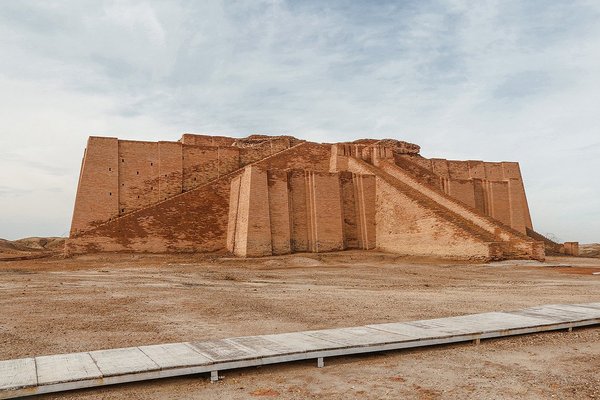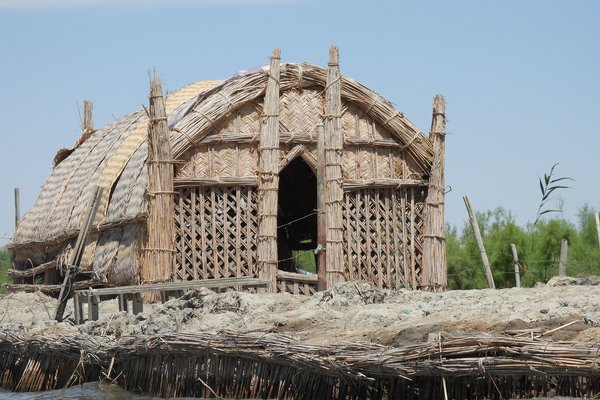Iraq
Ahwar of Southern Iraq
The Ahwar of Southern Iraq: refuge of biodiversity and the relict landscape of the Mesopotamian Cities covers the marshy delta that was home to the early Sumerian civilization.
The area lies in the joint delta of the Tigris and Euphrates Rivers, which provide arable fields through irrigation. It includes three archaeological sites of urban centers with monumental public architecture (Ur, Uruk, and Tell Eridu) and four wetlands (the Huwaizah Marshes, Central Marshes, East Hammar, and West Hammar Marshes), which are important for bird migration and fish species.
Community Perspective: Probably Iraq's best and most authentic WHS. The first reviewers have focused on the archeological sites, the Ziggurat of Ur being the most appealing monument. Els added one about the Central Marshes, while Clyde enjoyed Uruk.
Site Info
Official Information
- Full Name
- The Ahwar of Southern Iraq: refuge of biodiversity and the relict landscape of the Mesopotamian Cities (ID: 1481)
- Country
- Iraq
- Status
-
Inscribed 2016
Site history
History of Ahwar of Southern Iraq
- 2016: Advisory Body overruled
- ICOMOS & IUCN proposed deferral
- 2016: Revision
- Merger of 2 TWHS: The Marshlands of Mesopotamia & Ur
- 2016: Inscribed
- Inscribed
- 2015: Postponed
- evaluation postponed at the request of the State Party – letter dated 24/08/2014
- Type
- Mixed
- Criteria
- iii
- v
- ix
- x
Links
- UNESCO
- whc.unesco.org
All Links
UNESCO.org
- whc.unesco.org — whc.unesco.org/
News Article
- July 13, 2023 medyanews.net — Drought plagues Chibayish Marshes as Turkey, Iran hoard water
- Jan. 29, 2023 theguardian.com — Death in the marshes: environmental calamity hits Iraq’s unique wetlands
- May 3, 2022 artnews.com — British Tourist Accused of Smuggling Artifacts from Eridu
- Oct. 27, 2017 seattletimes.com — Iraq’s vast marshes, reborn after Saddam, are in peril again
- Dec. 29, 2016 iraqinews.com — Ministry condemns flamingos poaching at southern Iraqi provinces
- Nov. 16, 2016 birdlife.org — Jellyfish species sighted for first time in Iraq
Community Information
- Community Category
- Natural landscape: Rivers, Wetlands and Lakes
- Archaeological site: Near Eastern
Travel Information
Red Zone Travel Advisory
Recent Connections
-
Golden jackal
At the Hammar Marshes (wiki)
-
History of the World in 100 objects
Standard of UrSee www.bbc.co.uk
-
Untranslated Toponyms
"Ahwar" is Arabic for "Marshland"
Connections of Ahwar of Southern Iraq
- Individual People
-
-
Ibn Battuta
Possible: "But I set out for al-Basrah... Our way lay alongside the Euphrates [probably an error, since Ibn Battuta stops at Wasit en route to Basra, and Wasit is on the Tigris River] by the place known as al-Idhar, which is a water-logged jungle of reeds, inhabited by nomad Arabs called al-Ma'adi." -
Sir Wilfred Thesiger
Wrote The Marsh Arabs (1964), on his time living with the Marsh Arabs of Iraq.
-
- Geography
-
-
Tigris - Euphrates Basin
are situated at the confluence of the Tigris and Euphrates -
River deltas
joint delta of the Tigris and Euphrates River
-
- Trivia
-
-
Minority communities
Different tribes known together as 'Marsh Arabs'See en.wikipedia.org
-
Dubbed as another WHS
Uruk is dubbed Venice of the Desert (wiki) -
In the Pergamon museum
Inanna temple of Karaindash from Uruk. -
Former Largest Cities
Uruk: "At its height c. 2900 BC, Uruk probably had 50,000–80,000 residents living in 6 km2 (2.32 sq mi) of walled area; making it the largest city in the world at the time." (wiki). Eridu was the largest City around 3700 with 6000-10000. -
In Video Games
Age of Empire 1: A ziggurat of Ur for Babylonians, Persians and Hittites -
In the British museum
Uruk Trough (also Royal Game of Ur and Standard of Ur, which both may seen as portable)See en.wikipedia.org
-
- History
-
-
Located in a Former Capital
Ur was the capital of Sumer during the 3rd millennium BC -
Achaemenid Empire
Esagila Temple in Uruk -
Excavated by the Deutsche Orient-Gesellschaft
Uruk -
Mesopotamia
Includes the remains of the Mesopotamian cities of Uruk, Ur and Eridu -
Babylonian Empire
... offer a complete testimony to the growth and subsequent decline of southern Mesopotamian urban centers and societies from the Ubaid and Sumerian periods until the Babylonian and Hellenistic periods. (Nom file) -
Parthian Empire
Temple of Charyos in Uruk -
Assyrian Empire
Uruk went into a steep decline until about 850 BC when the Neo-Assyrian Empire annexed it as a provincial capital. Under the Neo-Assyrians and Neo-Babylonians, Uruk regained much of its former glory (wiki) -
Oldest Buildings
5000-3000 BC "The archaeological cities of Uruk and Ur and the Tell Eridu archaeological site form part of the remains of the Sumerian cities and settlements that developed in southern Mesopotamia between the 4th and the 3rd millennium BCE in the marshy delta of the Tigris and Euphrates rivers." -
Paid in Beer
Uruk: a tablet has been discovered that describes beer production at the Inanna Temple in Uruk and beer was given to workers as part of their daily rations. -
Akkadian Empire
"Uruk was ultimately annexed to the Akkadian Empire and went into considerable decline.", "Ur came under the control of the Akkadian Empire founded by Sargon the Great between the 24th and 22nd centuries BCE" (nom file)
-
- Ecology
-
-
Otters
Smooth-coated Otter -
Endemic Bird Species
Basra Reed Warbler and Iraq Babbler -
Bird Migrations
... comprise the last stopover area for millions of migrating birds before entering the vast Arabian Desert. (Nom file) & a major stopover point for shorebirds flying along the West Asian-East African flyway (AB ev) -
Flamingos
If they haven't all been eaten by now (see link), flamingos dwell in Shunafiyya, Chibaish and Hawizeh marshes -
Lagoons
Eridu was originally located in a lagoon -
Turtles and tortoises
"The property provides habitat for several reptiles including the Euphrates Soft-shell Turtle" (OUV) -
Fish
Crit IX: "It is also significant for the migration of fish and shrimp species from the Persian Gulf to the marshlands, with most of the fish species demonstrating diadromous characteristics (migratory between salt and fresh waters)." Crit X: ".. as well as 6 range-restricted fish species." -
Golden jackal
At the Hammar Marshes (wiki)
-
Swamps and Marshes
"The marshes also provide habitat for relict populations of three bird species (the African Darter, the Sacred Ibis, and the Goliath Heron) that are thousands of kilometres away from their core global populations in Africa." (OUV) - much of the marshland around the ancient cities is now dried
-
- Architecture
-
-
Mosaic art
Mosaic Temple in Uruk -
Earth Architecture
Sumerian sites
-
- Damaged
-
-
Damaged in War since WWII
Ziggurat of Ur: "The rebuilt ziggurat was damaged in the Gulf War in 1991 by small arms fire, and the structure was shaken by explosions.[12] Four bomb craters can be seen nearby, and the walls of the ziggurat are marred by over 400 bullet holes" (wiki)See en.wikipedia.org
-
- World Heritage Process
-
-
Postponed sites
In 2015 (for nomination in 2016): postponed at the request of the State Party -
Derived from more than one TWHS
Ur & Marshlands of Mesopotamia -
First sites filling gaps cited by ICOMOS
Mesopotamian cultures 2016 -
Mixed and Serial
3 archeological sites and 4 marshes
-
- Religion and Belief
-
-
Goddesses
Eanna, the temple of the Goddess Inanna at Uruk -
Mentioned in the Bible
Ur is considered by many to be the city of Ur Kasdim mentioned in the Book of Genesis as the birthplace of the Hebrew and Arab patriarch Abram ... There are however conflicting traditions and scholarly opinions identifying Ur Kasdim with the sites of Sanliurfa, Urkesh, Urartu or Kutha. Ur is mentioned four times in the Torah or Old Testament, with the distinction "of the Kasdim/Kasdin"—traditionally rendered in English as "Ur of the Chaldees". The Chaldeans were already settled in the vicinity by around 850 BC, but were not the rulers of Ur until the late 7th century BC, around 550 BC. The name is found in Genesis 11:28, Genesis 11:31, and Genesis 15:7. In Nehemiah 9:7, a single passage mentioning Ur is a paraphrase of Genesis. (Nehemiah 9:7) (wiki) -
Legends and Folk Myths
The Gilgamesh Epic originated from Uruk likely as a "reflection of the city's power and influence" (nom file)
-
- Human Activity
-
-
Sea Ports
Ur was a port at the Persian Gulf -
Writing systems
the centralized control of resources and surplus which gave rise to the first writing system and administrative archives (nom file). The earliest texts known were found in Uruk. -
Irrigation and drainage
draining the marshes and the building of dams and irrigation canals were major technological breakthrough first introduced under the Ubaid period and further perfected by the Sumerians who later built dams on the Tigris and Euphrates to expand agriculture far inland. (nom file)) -
Language isolate
Sumerian (Ur)
-
- Constructions
-
-
Canals
Uruk -
Tell
Tell Eridu Archaeological Site, and "The archaeological site of Uruk is composed of three ‘tells’ and there is evidence of multiple cities built on top of one another" (AB ev) -
Ziggurat
Each of the 3 ruined cities contains remains of Ziggurats. Tel Eridu: " Eighteen superimposed mudbrick temples at the site underlie the unfinished Ziggurat of Amar-Sin(c. 2047 – 2039 BC)." (Wiki) Uruk: "the Anu district consists of a single massive terrace, the Anu Ziggurat,dedicated to the Sumerian sky god, An" (Wiki). Ur: see linkSee en.wikipedia.org
-
Tombs
16 collective royal tombs in Ur
-
- WHS on Other Lists
-
-
Ramsar Wetlands
Huwaizah Marshes -
UNESCO Intangible Cultural Heritage Lists
Traditional craft skills and arts of Al-Mudhif buildingSee ich.unesco.org
-
Global Heritage Fund
Ur: Since 2009, the non-profit organization Global Heritage Fund (GHF) has been working to protect and preserve Ur against the problems of erosion, neglect, inappropriate restoration, war and conflict. (wiki) -
Part of Our Top 50 Missing
Ur
-
- Timeline
-
-
Holocene
The natural components ... as we know them today were formed 3000 years ago. (Nom file) -
Built in the 4th millennium BC
The cities flourished between 4th and 2nd millennium BC (AB ev)
-
- Science and Technology
-
-
Archaeological potential
Tell Eridu: "Only 1 to 2% of its surface has been excavated." (AB ev) -
Astronomy and Astrology
Bit Resh in Uruk: "The Bīt Reš along with the Esagila was one of the two main centers of Neo-Babylonian astronomy." (wiki) -
Excavated by American Universities
Ur was excavated by the University of Pennsylvania
-
- Visiting conditions
-
-
Red Zone Travel Advisory
All of Iraq except Kurdistan
-
- WHS Names
-
-
Untranslated Toponyms
"Ahwar" is Arabic for "Marshland"
-
- Literature & Film
-
-
History of the World in 100 objects
Standard of UrSee www.bbc.co.uk
-
News
- medyanews.net 07/13/2023
- Drought plagues Chibayish Marshes …
- theguardian.com 01/29/2023
- Death in the marshes: environmenta…
- artnews.com 05/03/2022
- British Tourist Accused of Smuggli…
Recent Visitors
Visitors of Ahwar of Southern Iraq
- Afshin Iranpour
- Alexander Lehmann
- ALKAREEMNASSER
- Christravelblog
- Clyde
- Cobaltrage
- Els Slots
- Eva Kisgyorgy
- Fan Yibo
- Gernot
- Harry Mitsidis
- henryjiao18
- Janos
- Loic Pedras
- Luis Filipe Gaspar
- marcel staron
- Marcobrey
- Martin
- Philipp Leu
- Szucs Tamas
- Thomas Buechler
- Timothy C Easton
- Wojciech Fedoruk
- Zoë Sheng
Community Reviews
Show full reviews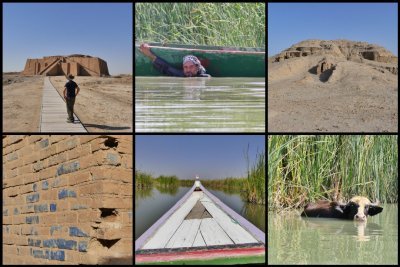
I visited this mixed WHS in September 2024 covering Ur, Uruk (Warka) and the Ahwar Marshes. Like most of Iraq's archaeological sites, the wealth of artefacts found is much more than what is left to see in situ. However, this is perhaps the best group of archaeological sites in terms of authenticity and what's left to see. This applies much more to Uruk than to Ur, although the iconic reconstructed Ziggurat of Ur is a worthy sight.
In Uruk, you literally feel you are trespassing in an archaeological dig, stepping on countless fragments of pottery, cuneiform mud bricks, glazed tiles and conical mosaics. The best time to visit is just before sunset, not only because it is burning hot here earlier, but mostly because all the building remains with glazed tiles and statues (mostly taken to the British Museum and to the Pergamon Museum in Berlin) light up in the afternoon sun. Among the best examples to be explored with a high-clearance car and a generous tip to the caretaker are the Inanna Temple, the Temple of Gareus, and the remains of a ziggurat. Uruk played a leading role in the early urbanization of Sumer in the mid-4th millennium BC, is nicknamed as the birthplace of writing, and possibly gave its name to modern Iraq. It is located east of the current bed of the Euphrates River, on an ancient, now-dried channel of the river. A whole room of artefacts (not to be missed!) has been dedicated to some …
Keep reading 0 comments
This should have been split into two WHS: one for the sites of the Ancient Sumerian civilization, one for the “New” Marshes. ICOMOS and IUCN suggested doing so and saw OUV in both, but the inscription was rushed through and now we’re stuck with a messy inscription and an unrecognizable site name.
I will focus my review on the Marshes and not on the archaeological sites. These Marshes are the so-called “New Marshes”, which originated about 3,000 years ago when the original marshes near the Sumerian cities dried out and the coastline moved south-east. They have been recognized because of their bird life and the connection to the life of the Marsh Arabs, whose traditional lifestyle was immortalized in the book by Wilfred Thesiger. A visit was included in my tour, but I wondered beforehand whether we would end up at the core zone or an area especially designed for tourists.
Already in the city of Nassiraya, the Marshes are signposted with the globally known brown road signs. We drove for 1 hour and 15 minutes to a place where they’ve built a reception area with boats for tourists and a few reed houses. It is near the shiny-silver Martyrs Monument in Chabaish, where at the entrance they even sport a full WHS plaque indicating the Central Marshes component. So core zone it definitely was! The Martyrs Monument commemorates the struggle of the Marsh Arabs against Saddam Hussein, who took a particular dislike to them as they actively rebelled …
Keep reading 0 comments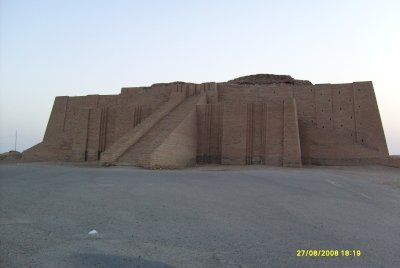
I visited this region of Iraq in the Fall of 2008. An opportunity arose for myself and some companions to visit the site of the ancient Sumerian city of Ur. I had seen pictures and read about the Ziggurat of Ur since I was a boy so I jumped at the chance. The greatest surprise was how extensive the ruins of the rest of the city are. We parked in the lot at the base of the Ziggurat and climbed up the steps to the top. From there the ruins reached out covering a vast area of the desert. Upon climbing down, we walked towards the rest of the ruins to explore but were stopped at the voice of a man calling to us from a distance. He approached and told us that the rest of the ruins were off-limits. We let him know that we meant no harm and were fascinated by the history of this ancient place. It was then that he introduced himself as Dhaif and explained that he was the caretaker of Ur. He said that his grandfather had been foreman of the workers during the archaeological excavations in 1922 and stayed on the site to take care of it after the British left. His father took over in the 1960's and he took over care of the place in the 1990's. He then offered to give us a tour of the entire place so, of course, we accepted. Over the next hour and a half …
Keep reading 0 comments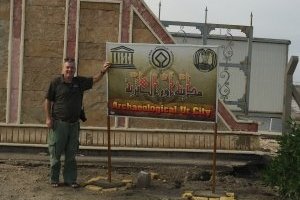
Ur was once an important Sumerian city state near the mouth of the Euphrates river, at the coast with marshy surroundings and regular floods and adverse weather impacts like erosions.Ur was already occupied as early as 6500 BC during the Urbaid period, but had its peak during the Sumerian period about 3000 BC. Buildings were made out of mudbricks and mud plaster. The main temple, Ziggurat of Ur, was built during king Ur-Nammu reign about 2040 BC. His codes of law (Hammurabi) is the oldest existing deciphered law writing in the world, the original at the Louvre museum, but replicas in many places including the National Museum of Iraq in Baghdad. On the basalt stele are 282 laws including the famous “an eye for an eye, a tooth for a tooth” rules. Ur is also mentioned four times in the Old Testament and in the Book of Genesis as the birthplace of Abraham 2000 BC.The site was first excavated 1853 by the British Museum and the British Vice Consul in Basra who also uncovered the Ziggurat (main temple dedicated to the Moon god Nanna)It was later on reconstructed, including its monumental staircase. However, the third level has collapsed, and its present height is 17 meters from the original of 26. Ur is surrounded by 2 ramparts constructed during Sumerian and Babylonian times. The closest city with infrastructure is Nasariyah, it has decent hotels and restaurants and at present no security problems. We have also visited Uruk where we could talk …
Keep reading 0 comments
